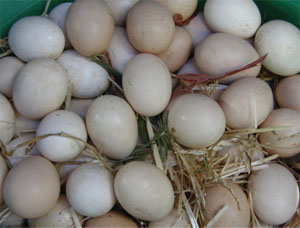12.5.2 Handling eggs
Although most freshly laid eggs are sterile inside, the shells soon become contaminated by faecal matter from the hen and the lining of the nest. When collecting eggs, any visible dirt should be rubbed off the shells. During handling, contamination can also arise from washing water and from any packing material. However, some eggs will be spoiled on the inside, generally because of cracks in the eggshell through which bacteria can enter. It is important to test for egg spoilage, and this can be done in the following ways.
Inspection
Eggs should first be inspected for cracks, leaks, stains or dirt on the exterior and general bloodiness or translucent spots in the yolk when candled (see below). You are looking for freshness, soundness, size and cleanliness of the shell (Figure 12.11).

Shaking
A fresh egg makes no sound, but a stale (bad) egg makes a sound when shaken.
Candling
This is performed by holding the egg between the eye and a light such as a candle flame or the sun. As the shell is translucent, you can assess the internal quality and the size of the yolk.
Floating
Fresh eggs usually sink to the bottom of a bowl of water, whereas spoiled eggs float and can be removed. Floating occurs because, in spoiled eggs, the air cavity is bigger, which makes the egg more buoyant. The problem with this method is that the water may penetrate through the eggshell pores so it is important to use clean water, change it frequently and not to leave eggs in the water.
Breaking
In this test, around 10 eggs out of 100 are taken randomly and checked for spoilage by breaking them open to see what is inside. This is the most accurate testing method but it is not cost-effective, so is only used when the other methods are not exercised – for example, in large-scale operations.
12.5.1 Poultry keeping and processing
